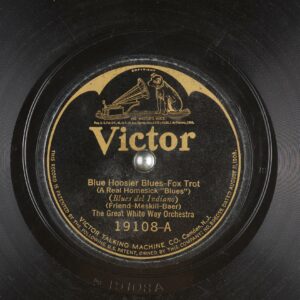Table of Contents
The Great White Way Orchestra
Introduction
Named after the famous nickname for New York City’s theater district, Broadway, The Great White Way orchestra embodied the vibrant spirit of the era’s entertainment scene. While they may not be as widely remembered as some of their contemporaries, they played a crucial role in bringing the sounds of Broadway and popular music to a wider audience through their recordings.

Career
The Great White Way Orchestra’s career was intrinsically linked to the burgeoning recording industry of the early 20th century. While specific details about the orchestra’s formation are scarce, their recordings began appearing in the late 1910s and continued into the early 1920s. What we do know is that they were primarily a studio ensemble, created to record popular songs of the day for various record labels. Their name would have been instantly recognizable to audiences of the time, evoking images of the glittering lights and musical magic of Broadway.
One of the most significant aspects of The Great White Way Orchestra’s career was their association with Victor Records. Victor Records was the major player in the early recording industry, and the orchestra recorded numerous sides for them.
The orchestra’s repertoire was diverse, reflecting the popular tastes of the era. They recorded everything from waltzes and foxtrots to novelty songs and early jazz numbers. Some of their notable recordings include:
- “When Winter Comes” (1922) – A melancholic ballad that showcased the orchestra’s ability to convey emotion through instrumental performances.
- “Beside a Babbling Brook” (1923) – This nature-inspired piece likely capitalized on the popularity of pastoral themes in early 20th-century popular music.
- “Blue Hoosier Blues” (1923) – A song that reflected the growing influence of blues on mainstream popular music of the early 1920s.
The Great White Way Orchestra often featured prominent session musicians of the day, though these players typically remained uncredited. This anonymity was common practice for studio orchestras of the era, with the ensemble name taking precedence over individual musicians.
As the 1920s progressed and tastes began to shift more decidedly towards jazz and dance band music, the demand for orchestras like The Great White Way began to wane. However, their recordings remain valuable snapshots of a transitional period in American popular music, capturing the sound of an era poised between the genteel traditions of the past and the rhythmic innovations of the Jazz Age.
Impact on Music and Culture
The Great White Way Orchestra, while perhaps not as widely remembered as some of their contemporaries, played a significant role in shaping the musical landscape of the early 1920s. Their impact on music and culture can be observed in several key areas:
- Bridging Musical Eras: The orchestra served as a crucial link between the more formal, structured music of the 1910s and the looser, more rhythmic styles that would define the Jazz Age. Their recordings of songs like “When Winter Comes” (1922) and “Blue Hoosier Blues” (1923) demonstrate this transition, incorporating elements of traditional orchestration while hinting at the syncopated rhythms that were becoming increasingly popular.
- Popularizing Broadway Tunes: As their name suggests, The Great White Way Orchestra was closely associated with Broadway. By recording and distributing popular show tunes, they helped to disseminate Broadway music beyond the confines of New York City, allowing audiences across the country to experience the latest theatrical hits.
- Advancing Recording Technology: Through their work with Edison Records and their Diamond Disc format, the orchestra played a part in pushing forward the quality and fidelity of recorded music. Their crisp, clear recordings on this advanced format helped to set new standards for the industry.
- Preserving Popular Music: The Great White Way Orchestra’s recordings serve as a time capsule of popular music in the early 1920s. Songs like “Beside a Babbling Brook” capture the tastes and trends of the era, providing valuable insights for musicologists and historians studying this period of American culture.
- Influencing Arrangement Styles: The orchestra’s adaptations of popular songs for instrumental performance helped to establish patterns of arrangement that would influence big band and swing music in the following decades. Their ability to translate vocal-centric pieces into engaging instrumental performances was particularly noteworthy.
- Supporting the Dance Craze: The early 1920s saw a boom in social dancing, and orchestras like The Great White Way were at the forefront of providing music for this cultural phenomenon. Their recordings of foxtrots and other popular dance rhythms contributed to the soundtrack of the era’s vibrant dance hall scene.
- Democratizing Music Consumption: By recording for major labels and producing high-quality discs, The Great White Way Orchestra contributed to the growing trend of home music consumption. Their records allowed people to enjoy professional-quality performances in their own living rooms, a novelty that was rapidly changing the way Americans experienced music.
While The Great White Way Orchestra may not have been revolutionary in their musical style, their role in disseminating popular music, advancing recording technology, and bridging different musical eras makes them an important part of early 20th-century American musical culture. Their work laid the groundwork for the more dramatic musical innovations that would follow in the later 1920s and beyond.
